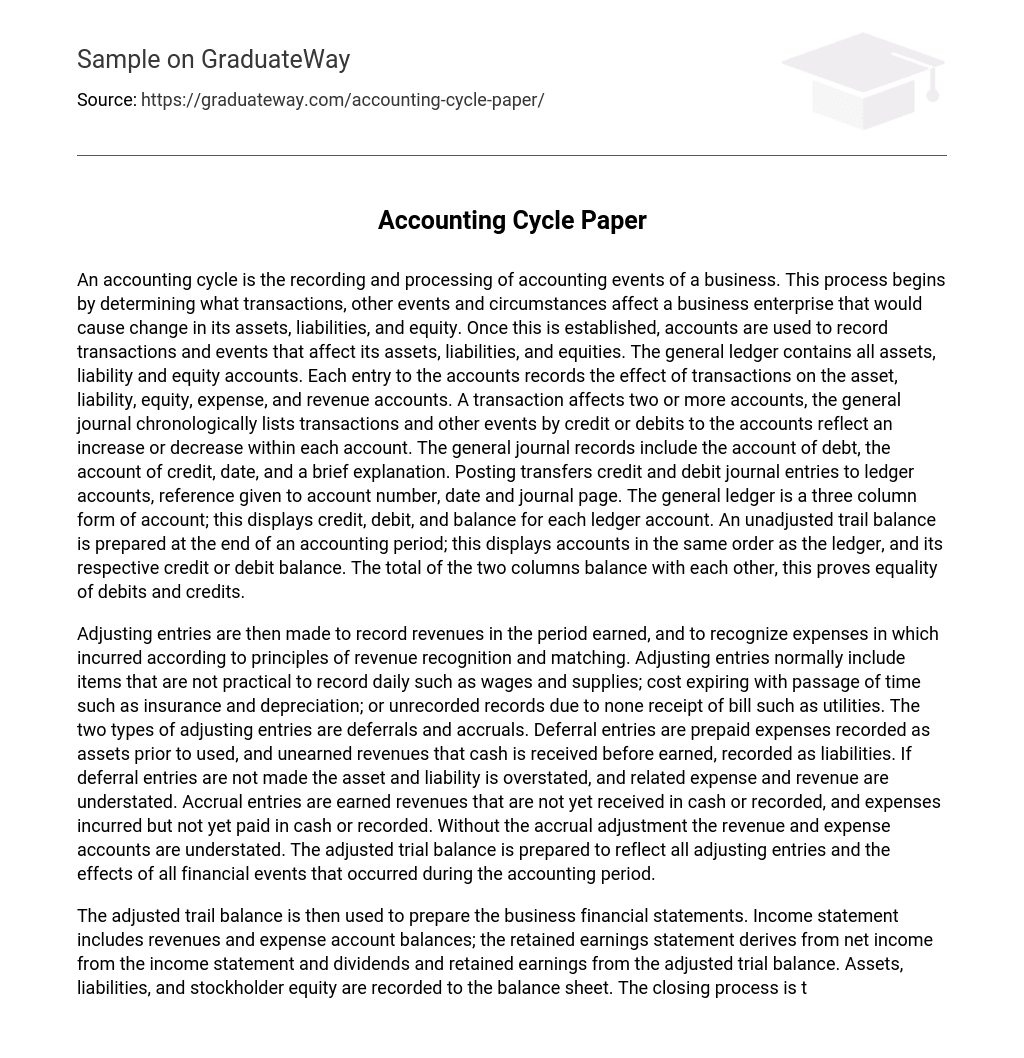An accounting cycle is the recording and processing of accounting events of a business. This process begins by determining what transactions, other events and circumstances affect a business enterprise that would cause change in its assets, liabilities, and equity. Once this is established, accounts are used to record transactions and events that affect its assets, liabilities, and equities. The general ledger contains all assets, liability and equity accounts. Each entry to the accounts records the effect of transactions on the asset, liability, equity, expense, and revenue accounts. A transaction affects two or more accounts, the general journal chronologically lists transactions and other events by credit or debits to the accounts reflect an increase or decrease within each account. The general journal records include the account of debt, the account of credit, date, and a brief explanation. Posting transfers credit and debit journal entries to ledger accounts, reference given to account number, date and journal page. The general ledger is a three column form of account; this displays credit, debit, and balance for each ledger account. An unadjusted trail balance is prepared at the end of an accounting period; this displays accounts in the same order as the ledger, and its respective credit or debit balance. The total of the two columns balance with each other, this proves equality of debits and credits.
Adjusting entries are then made to record revenues in the period earned, and to recognize expenses in which incurred according to principles of revenue recognition and matching. Adjusting entries normally include items that are not practical to record daily such as wages and supplies; cost expiring with passage of time such as insurance and depreciation; or unrecorded records due to none receipt of bill such as utilities. The two types of adjusting entries are deferrals and accruals. Deferral entries are prepaid expenses recorded as assets prior to used, and unearned revenues that cash is received before earned, recorded as liabilities. If deferral entries are not made the asset and liability is overstated, and related expense and revenue are understated. Accrual entries are earned revenues that are not yet received in cash or recorded, and expenses incurred but not yet paid in cash or recorded. Without the accrual adjustment the revenue and expense accounts are understated. The adjusted trial balance is prepared to reflect all adjusting entries and the effects of all financial events that occurred during the accounting period.
The adjusted trail balance is then used to prepare the business financial statements. Income statement includes revenues and expense account balances; the retained earnings statement derives from net income from the income statement and dividends and retained earnings from the adjusted trial balance. Assets, liabilities, and stockholder equity are recorded to the balance sheet. The closing process is to reduce temporary accounts to a zero balance. This transfers revenue and expense account balances to the Income summary account. This account represents net income or loss for the annual accounting period. This amount is then transferred to owners equity account. Preparing a closing trial balance provides proof the accounting equation is in balance at the end of the accounting period.
The organization, Ghoster Media is a small start up business. The organization produces Utube content, owns a Utube channel and is agent/owner of a competitive gaming team. As a recent start up operation, owner equity is recorded as cash. The accounting cycle begins with collecting and analyzing data from transactions and events each accounting period, entries are made to selected ledger accounts to record business events and transactions. Purchases of video and editing equipment are depreciated using straight line method, allocating the cost of the assets to expense over its useful life. Transactions are recorded into a general journal, job orders track completed and work in progress. Recording of jobs cost is an automated process through a separate system, labor and expenses are then recorded into general journal buy job numbers captured through the job order process. Rent, utilities are accrued at a monthly fixed rate, supply entries are performed at end of job completion through job order numbers. The company post monthly entries to the general ledger, prepares an unadjusted trial balance, makes adjusting entries for prepaid expenses, unearned revenues, accrued expenses and revenues as appropriate. The adjusted trial balance is prepared and used to produce the company financial statements, expenses are compared to budgets and bids, and bank ledgers balanced to owner equity.





